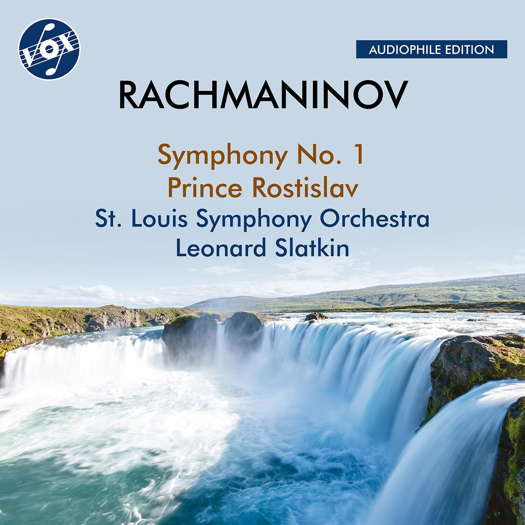- La bohème
- Henri Meilhac
- Joachim Mendelson
- Hugo Mak
- Rachel Holt
- Grace Williams: Carol Nadolig
- Michael John Haden: Hymn to Love
- Håkan Hardenberger

Colourful and Exciting
GEOFF PEARCE listens to early orchestral music by Sergei Rachmaninov conducted by Leonard Slatkin
'... this reissue is most welcome ...'
Like so many music lovers, I really love Rachmaninov. I am quite familiar with the second and third symphonies, but the first is not so often performed, and was not highly regarded when it was introduced to the public. This recording, dating back to 1977 and 1982, uses a great combination of Leonard Slatkin and the St Louis Symphony Orchestra. (I have other recordings of these forces and have been impressed.) The album includes a Rachmaninov symphonic poem that I did not know, and in fact it was not performed in the composer's lifetime.
Symphony No 1 was composed in 1895 and is in four movements. I am at a loss to know why this was not well received - I guess it was under prepared for performance, and Glazunov, the conductor, was somewhat drunk. The failure of this work caused the composer to suffer a nervous collapse that took him some time to come out of. It was thought that this piece had been lost as the composer tore up the score, but the orchestral parts were later discovered, the work reconstructed, and the first performance of this reconstructed score occurred in 1948.
The Symphony opens with a flourish - a rather menacing grupetto - and a few bars later a bold theme is introduced, that soon dissipates into a slower lyrical section. In this section there are some very lovely solos - particularly the oboe. The tonality is somewhat ambiguous. The slow section is followed by a busy fugato section. The music is unmistakably Rachmaninov, with the flavour of Tchaikovsky and some of the Russian Five.
Listen — Rachmaninov: Allegro non troppo (Symphony No 1 in D minor, Op 13)
(VOX-NX-3029CD track 1, 11:33-12:18)
℗ 1977 Vox Productions Inc / 2023 Naxos Rights Europe Ltd :
The second movement also starts with that grupetto, and it takes a few bars for the momentum to assert itself. This is a rather fantastic scherzo with exuberant energy. This does give way to an expressive middle section with an almost gypsy air violin solo, but the intensity is not lost and there is always this boundless energy that comes in waves.
Listen — Rachmaninov: Allegro animato (Symphony No 1 in D minor, Op 13)
(VOX-NX-3029CD track 2, 5:52-6:35)
℗ 1977 Vox Productions Inc / 2023 Naxos Rights Europe Ltd :
The slow third movement also opens with the grupetto figure, but here it does not have the rather menacing quality of the first two movements. The overall feeling is lyrical and calm, and there are some lovely solos for clarinet, oboe, flute, muted horns and undulating strings, from which beautiful melodies emerge. There is some tension in the middle of this movement that threatens to derail the calm of the opening, but although it climaxes, it subsides very quickly. This is probably one of my favourite movements of all the Rachmaninov I know.
Listen — Rachmaninov: Larghetto (Symphony No 1 in D minor, Op 13)
(VOX-NX-3029CD track 3, 6:06-6:54)
℗ 1977 Vox Productions Inc / 2023 Naxos Rights Europe Ltd :
The final movement, again starts with that grupetto and this is followed by a march theme, which, like the first two movements, is based on the Dies Irae. There are many changes of character and meter in this movement, and other moments of sweeping almost cinematic epic string writing. It is a colourful and exciting movement, and I am honestly astonished that it does not get more frequent hearing.
Listen — Rachmaninov: Allegro con fuoco (Symphony No 1 in D minor, Op 13)
(VOX-NX-3029CD track 4, 4:33-5:18)
℗ 1977 Vox Productions Inc / 2023 Naxos Rights Europe Ltd :
The other work, Prince Rostislav (1891), was a student work of Rachmaninov, dedicated to Arensky who was one of his teachers. Rachmaninov made no attempt to get the work performed so this didn't happen until a couple of years after the composer died. It is based on a ballad by Tolstoy which tells of Prince Rostislav of Pereyaslavl (1070-1093) who, after losing a battle against a superior force with his brothers, fled and was drowned whilst crossing a river. It is a very interesting and colourful work, and the melodic and flair for orchestration are very evident, even in this youthful work. It is certainly a great pairing with the symphony. The first half is rather sad and brooding, but this changes and the music is filled with tension and movement, perhaps depicting either the battle or the flight.
Listen — Rachmaninov: Prince Rostislav
(VOX-NX-3029CD track 5, 10:57-11:55)
℗ 1977 Vox Productions Inc / 2023 Naxos Rights Europe Ltd :
The last part is sorrowful and reflective, and the work ends quietly and sadly.
As I said earlier, I have been impressed by Slatkin and the St Louis forces before, and I own their set of the Schumann symphonies which is dear to my heart. This recording is equally fine. As neither work is particularly well represented by recordings, in comparison to many of the composer's other works, this reissue is most welcome, The remastering is very good. It is a pity that the notes accompanying this disc are very brief and do not really do the disc justice.
Copyright © 5 December 2023
Geoff Pearce,
Sydney, Australia





